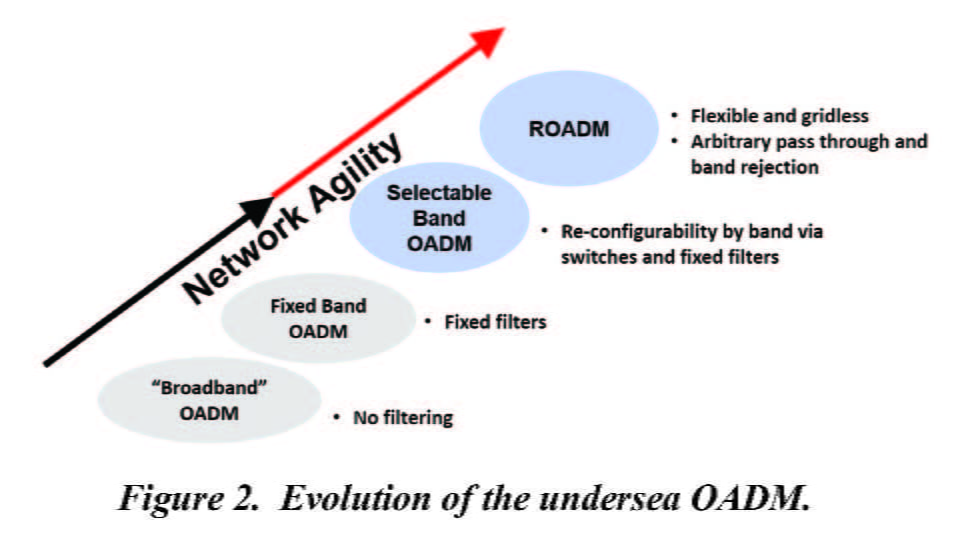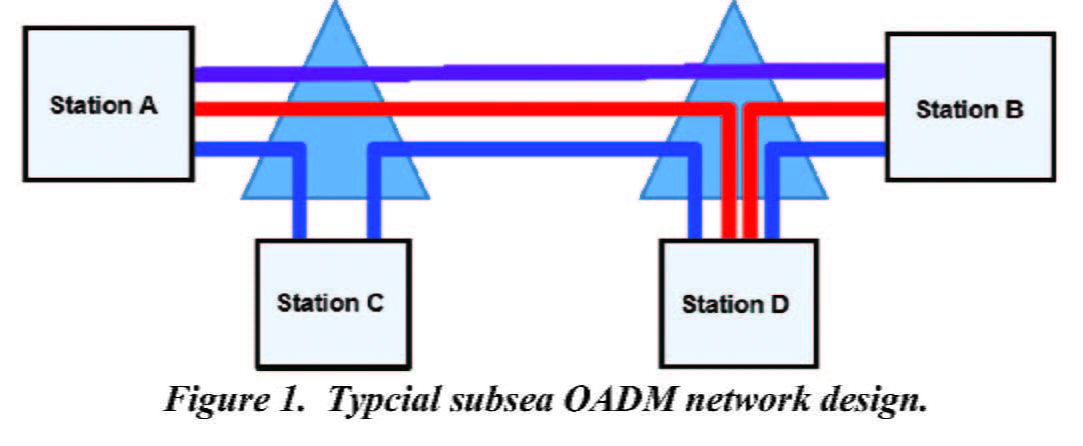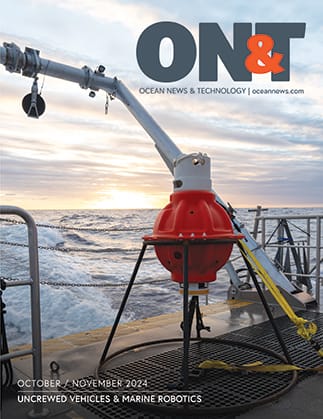Flexibility in Undersea Networks
By: Edwin Muth, Director Product Line Management – TE SubCom, Bruce Nyman, Senior Director – TE SubCom,
Janar Thoguluva, Product Line Manager – TE SubCom, Karen Knauf, Product Line Manager – TE SubCom
Submarine networks with multiple system endpoints utilize a trunk and branch architecture (Figure 1), with undersea branching nodes to route traffic to specific branches using optical add drop multiplexing (OADM) wavelength routing technology. Over the last decade, undersea OADM has proven to be a costeffective method to share the capacity among several customers on a single fiber pair among multiple point-to-point connections in a trunk-and-branch undersea network.
In a fixed OADM system (in which the filters in the undersea network elements are not reconfigurable), the bandwidth allocated to each cable station is determined at the time the system is designed. In many cases, a consortium owning a submarine cable system includes multiple parties from a number of countries. As such, it is difficult to predict the capacity requirements of every cable station in a system over the typical 25-year system lifetime. Over time, the required capacity for any cable station in the system may change or new cable stations may be added to the system.
Similarly, a single owner of a fiber pair on a multiple fiber pair system would find some value in addressing shifting capacity needs over the two or three decades of system life. These potential changes in the system utilization drive the desire to increase flexibility and re-configurability in the undersea plant by allowing new methods to reallocate capacity. Content provider networks and large cloud networks are examples that could benefit from this increased flexibility. The ability to control the allocation of the available bandwidth will become more desirable over time as bandwidth on demand services and Software Defined Networks are implemented by operators.
Finally, an important requirement of undersea networks is the ability to recover from cable cuts and protect traffic that is not expected to be directly affected by a cable cut (e.g., recover trunk traffic after a branch cut). The ability to flexibly reconfigure undersea networks greatly helps improve traffic continuity after a fault occurs. Below, we discuss some of the tools needed to achieve the flexibility described above.
The submarine network elements that enable flexibility are similar in function to those used today in terrestrial networks. Due to the very high reliability demands of submarine networks, not all of the technologies available in terrestrial networks can meet the stringent qualifications required for undersea use. Broadband splitters and fixed filters have been qualified for fixed OADM undersea networks since the mid-2000s. Active components for switching and reconfigurable OADMs have been qualified for undersea in more recent years. End-to-end agile undersea networks require both undersea and land-based agile network elements.
An evolution of the undersea branching network element is shown in Figure 2. Undersea branching network elements combining broadband optical switches with fixed filters allow operators to remotely select among a limited number of bands, thus adding great flexibility to their network. Undersea ROADMs provide the ultimate flexibility as arbitrary pass-through and band rejection are made possible in the optical band for the trunk and the branch, thus allowing more or less traffic on the branch as needed.

The flexibility in the undersea network elements must be matched with complementary capability shore side. Coherent 100 Gb/s transponders are already flexible as they can be tuned to different wavelengths and adapt automatically to different fiber path lengths by compensating dispersion electronically. Since undersea repeaters require the equivalent of full capacity across the available band, Initial Loading Equipment (ILE) (i.e., power added across the amplifier bandwidth to simulate traffic) based on Wavelength Selective Switch (WSS) technology is required to dynamically match the desired network configuration. Similarly, coastal ROADMs are tuned to allow the desired wavelengths to pass through to the submarine system. The Network Management System (NMS) controls all the network elements (land-based ROADM, undersea ROADM, WSS-based ILE, transponders, etc.) as capacity is reallocated to meet the operators’ needs and ensure system performance under normal operation. The NMS also orchestrates fault recovery to protect the system traffic from trunk or branch cable cuts resulting, for example, from external aggression. The recovery action may consist of changes in optical loading tones, reconfiguration of undersea network elements, or both.
Cable cuts due to external aggression are one of the most common causes of faults. When an outage occurs, OADM technology can reroute or bypass optical paths to maintain system operation. In a submarine system, it may take many days for a repair, so it is important to maintain as much of the system capacity as possible during a fault.
In conclusion, there are a number of reasons to create a dynamic undersea network. Bandwidth on demand, data center capacity variations over time of day or long term, and economic growth being unequal in different countries all demand some level of network flexibility. Peak traffic events may require increased capacity in a given country or region for a limited period of time. Regardless of the reasons for the need for submarine network re-configurability, technologies exist to match the operations flexibility currently enjoyed by the terrestrial networks.
Because of the limited margins in submarine systems, however, special measures unique to submarine systems need to be taken to ensure continued performance in the reconfigured state. Additionally, cable faults caused by events such as ship dragging or earthquakes are more easily managed with a re-configurable network. The control mechanism and the network elements will work hand-in-hand to help maximize network utilization. In short, the technical solutions are available today to globally interconnect flexible terrestrial networks through an equally flexible submarine network and create a truly dynamic global network.

